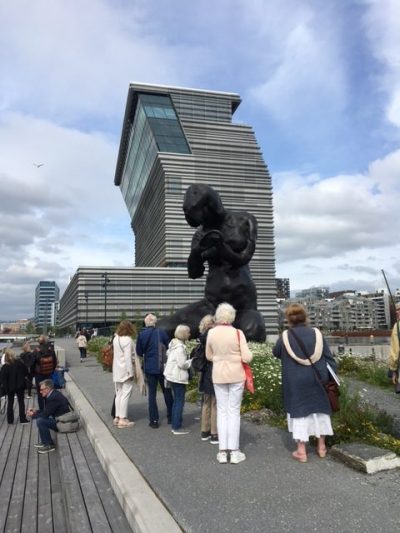A new statue called Moren (The Mother) has been attracting attention all week. Not all of it good, but artist Tracey Emin couldn’t care less. “Let them hate it,” she told Norwegian Broadcasting (NRK) after her latest work of art was unveiled just next to the still-new MUNCH museum in Oslo.

The 18-ton sculpture that rises more than 30 feet above Oslo’s eastern waterfront at Bjørvika is already both loved and hated. Emin, according to Norwegian art critic Lars Elton, formed it from a sympathetic idea: to have a large, kneeling female figure holding something we can’t see.
The idea was for the sculpture to sit alongside the spirit of famed Norwegian artist Edvard Munch’s works that are now housed in the adjacent tall building, which in turn is bowing to the neighbouring Norwegian Opera House. It’s supposed to hail all mothers, Elton wrote in newspaper Dagsavisen before the sculpture was hoisted into place last weekend.
Munch, Elton noted, lost his own mother Laura, when he was only five years old in 1868, the same year his youngest sister Inger was born. Munch’s mother’s death and the death of his older sister Johanne Sophie from tuberculosis in 1877 were central themes in much of Munch’s art.
Emin has said she’s long been inspired by Munch’s work, and another of her large art installations was part of the opening exhibits when MUNCH itself opened last fall. Corona delayed both the opening and the placement of The Mother, which was supposed to have been unveiled last year.
Stein Slyngstad, head of Oslo’s cultural affairs agency that commissioned the work (Kulturetaten), called it “very unfortunate” that production took longer than expected because of reduced staffing at the two foundries in England where the scupture was cast. Imports of the bronze used in the statue were also delayed and then entry restrictions into Norway prevented the artist’s subcontractor from being able to inspect the area where the sculpture would placed.
Concerns about assembly during winter further delayed the project, but its components were eventually transported by ship to Norway in late March and welded together just across the river from where it’s placed, at what’s called Inger Munch’s Pier. Now Slyngstad is confident the sculpture “will last for several hundred years.”

The naked, unpolished adult female figure is meant to be both raw and vulnerable at the same time. While some have called it a “big blob” and critics have described The Mother’s hands and feet as “clumps,” others have appreciated its depiction of motherhood. Elton compared it to the deformed face of The Elephant Man in David Lynch’s film from 1980.
It’s meant to be another new attraction for the Norwegian capital, with the city’s own cultural officials calling it a “location-specific artwork and a symbol of Oslo’s harbour area. She can be seen as a mother for nature, for humanity and for our city.”
Elton agrees that the omsorg (caring) expressed by the statue “will stand as its most important quality.” It was selected among several other candidates for the harbour location in an international competition in 2018.
“One can wonder why the city’s jury didn’t choose a Norwegian artist instead,” Elton mused, “but we can’t rule out that Tracey Emin was chosen because she’s an internationally well-known and scandalous artist. The Munch museum will generate tourist traffic and such factors can attract more.”
There’s certainly been no lack of spectators around the statue this week, including groups out on organized art tours. Elton also noted that since most sculture tradition has been dominated by men, both in Norway and internationally, Emin’s “feminist dimension” with caring and protection as a theme, can contribute to correcting an artistic bias.
newsinenglish.no/Nina Berglund

